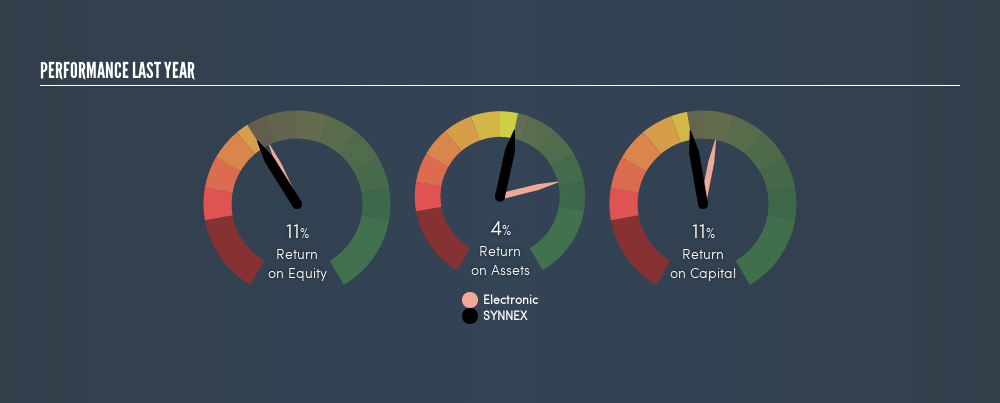Here’s What SYNNEX Corporation’s (NYSE:SNX) Return On Capital Can Tell Us

Want to participate in a short research study? Help shape the future of investing tools and you could win a $250 gift card!
Today we'll look at SYNNEX Corporation (NYSE:SNX) and reflect on its potential as an investment. To be precise, we'll consider its Return On Capital Employed (ROCE), as that will inform our view of the quality of the business.
Firstly, we'll go over how we calculate ROCE. Then we'll compare its ROCE to similar companies. And finally, we'll look at how its current liabilities are impacting its ROCE.
What is Return On Capital Employed (ROCE)?
ROCE measures the amount of pre-tax profits a company can generate from the capital employed in its business. All else being equal, a better business will have a higher ROCE. Ultimately, it is a useful but imperfect metric. Author Edwin Whiting says to be careful when comparing the ROCE of different businesses, since 'No two businesses are exactly alike.'
So, How Do We Calculate ROCE?
The formula for calculating the return on capital employed is:
Return on Capital Employed = Earnings Before Interest and Tax (EBIT) ÷ (Total Assets - Current Liabilities)
Or for SYNNEX:
0.11 = US$737m ÷ (US$11b - US$4.5b) (Based on the trailing twelve months to May 2019.)
So, SYNNEX has an ROCE of 11%.
View our latest analysis for SYNNEX
Does SYNNEX Have A Good ROCE?
When making comparisons between similar businesses, investors may find ROCE useful. We can see SYNNEX's ROCE is around the 12% average reported by the Electronic industry. Regardless of where SYNNEX sits next to its industry, its ROCE in absolute terms appears satisfactory, and this company could be worth a closer look.

It is important to remember that ROCE shows past performance, and is not necessarily predictive. ROCE can be misleading for companies in cyclical industries, with returns looking impressive during the boom times, but very weak during the busts. This is because ROCE only looks at one year, instead of considering returns across a whole cycle. What happens in the future is pretty important for investors, so we have prepared a free report on analyst forecasts for SYNNEX.
SYNNEX's Current Liabilities And Their Impact On Its ROCE
Short term (or current) liabilities, are things like supplier invoices, overdrafts, or tax bills that need to be paid within 12 months. The ROCE equation subtracts current liabilities from capital employed, so a company with a lot of current liabilities appears to have less capital employed, and a higher ROCE than otherwise. To counter this, investors can check if a company has high current liabilities relative to total assets.
SYNNEX has total liabilities of US$4.5b and total assets of US$11b. As a result, its current liabilities are equal to approximately 40% of its total assets. SYNNEX has a medium level of current liabilities, which would boost the ROCE.
What We Can Learn From SYNNEX's ROCE
While its ROCE looks good, it's worth remembering that the current liabilities are making the business look better. There might be better investments than SYNNEX out there, but you will have to work hard to find them . These promising businesses with rapidly growing earnings might be right up your alley.
For those who like to find winning investments this free list of growing companies with recent insider purchasing, could be just the ticket.
We aim to bring you long-term focused research analysis driven by fundamental data. Note that our analysis may not factor in the latest price-sensitive company announcements or qualitative material.
If you spot an error that warrants correction, please contact the editor at editorial-team@simplywallst.com. This article by Simply Wall St is general in nature. It does not constitute a recommendation to buy or sell any stock, and does not take account of your objectives, or your financial situation. Simply Wall St has no position in the stocks mentioned. Thank you for reading.
About NYSE:SNX
TD SYNNEX
Operates as a distributor and solutions aggregator for the information technology (IT) ecosystem.
Undervalued with proven track record.
Similar Companies
Market Insights
Community Narratives





